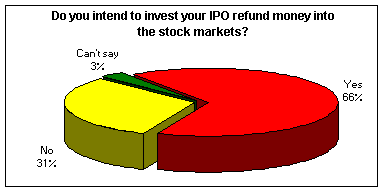
Home > Business > Business Headline > Report
Where are the IPO refunds going?
March 25, 2004 12:31 IST
The Indian stock markets have been in a strong correction mode since the last few weeks. While there are various reasons doing the rounds of the markets as the possible cause of the recent fall in stock markets, one of the prominent ones have been the deluge of IPO offerings that hit the markets in February-March of 2004. This resulted in a liquidity crunch in the secondary markets, as investors unwound their current holdings to raise capital in order to participate in these offerings. The response to the IPOs, including the 6 government offerings, was overwhelmingly positive. While the oversubscription of these IPOs is in itself a big indication of their success, what was worth noting is the fact that retail participation in these IPOs was particularly impressive, the reason for which is not difficult to find. With the government offering its stake at a 5 per cent discount to retail investors over the final price arrived at post the book-building process and the huge difference prevailing between the current stock price and the price of the equity that was being offered, investors naturally found it a hard-to-resist bargain. This probably led to profit-booking on the bourses, as investors cashed out of stocks and invested the sums raised in these IPOs. Keeping this in mind, we conducted a poll trying to gauge the investors action post the close of the IPOs as they receive their refunds owing to non-allotment of shares.  The poll conducted was, 'Do you intend to invest your IPO refund money into the stock markets?' It was encouraging to see the final results, which pointed to the fact that almost 2/3rd of the IPO refunds (66%) will find its way into the stock markets (see chart above). The balance largely preferred to stay away from the secondary markets. It must be noted that the six government offerings formed the bulk of the value of the primary market issues in 2004. There were others also like Power Trading Corporation and Petronet LNG, which tapped the markets for raising funds. The total issue size of all these offerings was in the vicinity of Rs 150 billion and practically all these issues were oversubscribed. Even the retail part of the issue showed healthy oversubscription rates with 'oversubscription' being the minimum in the case of IPCL at 1.3 times and the maximum being 42 times in case of PTC! Thus, considering the fact that an average 25 per cent of the total issue (the above 8 IPOs) was reserved for the retail public and considering the oversubscription rates of these issues, a back of the envelope calculation indicates that of the Rs 37 billion targeted by the government to be raised through retail participation, the government actually received Rs 54 billion, which is almost 50 per cent higher than what it had aimed for! This excess, of course, would be refunded back to the retail investors. Further, it must be noted that this is just the retail portion of the issue. The participation from FIIs and QIBs (Qualified Institutional Buyers) was equally overwhelming. What causes the oversubscription is the fact that during bull runs, the strong positive sentiments prevailing on the bourses leads to investors expecting the issue to get oversubscribed. Keeping this in mind, and wanting to have a larger chunk of the issue, investors tend to bid for a larger number of shares, which puts a strain on their liquidity position forcing them to sell some of their current holdings wherein they are sitting on profits. Of course, the quality of the issue also has a very important role to play in the issue being fully subscribed or oversubscribed. Naturally, in such times, investors are allotted only a part of what they had actually bid for, the balance being refunded to the investors. The same also holds true for the other category of bidders in the issue. This refunded money, if it finds its way back into the stock markets, as indicated by the poll, investors could once again be riding the bull, albeit a slower one, considering that the indices have already skyrocketed in the last one year. While this could be just one of the reasons that could once again prop up the markets, a rationale investor should consider the fact that nothing has changed fundamentally since December 2003 and now. The government continues to promise an 8 per cent GDP growth going forward and the if the recent manufacturing numbers are any indication, the government could actually deliver, considering that the monsoon remains more or less normal. So, don't lose heart. Happy investing! Equitymaster.com is one of India's premier finance portals. The web site offers a user-friendly portfolio tracker, a weekly buy/sell recommendation service and research reports on India's top companies.
|